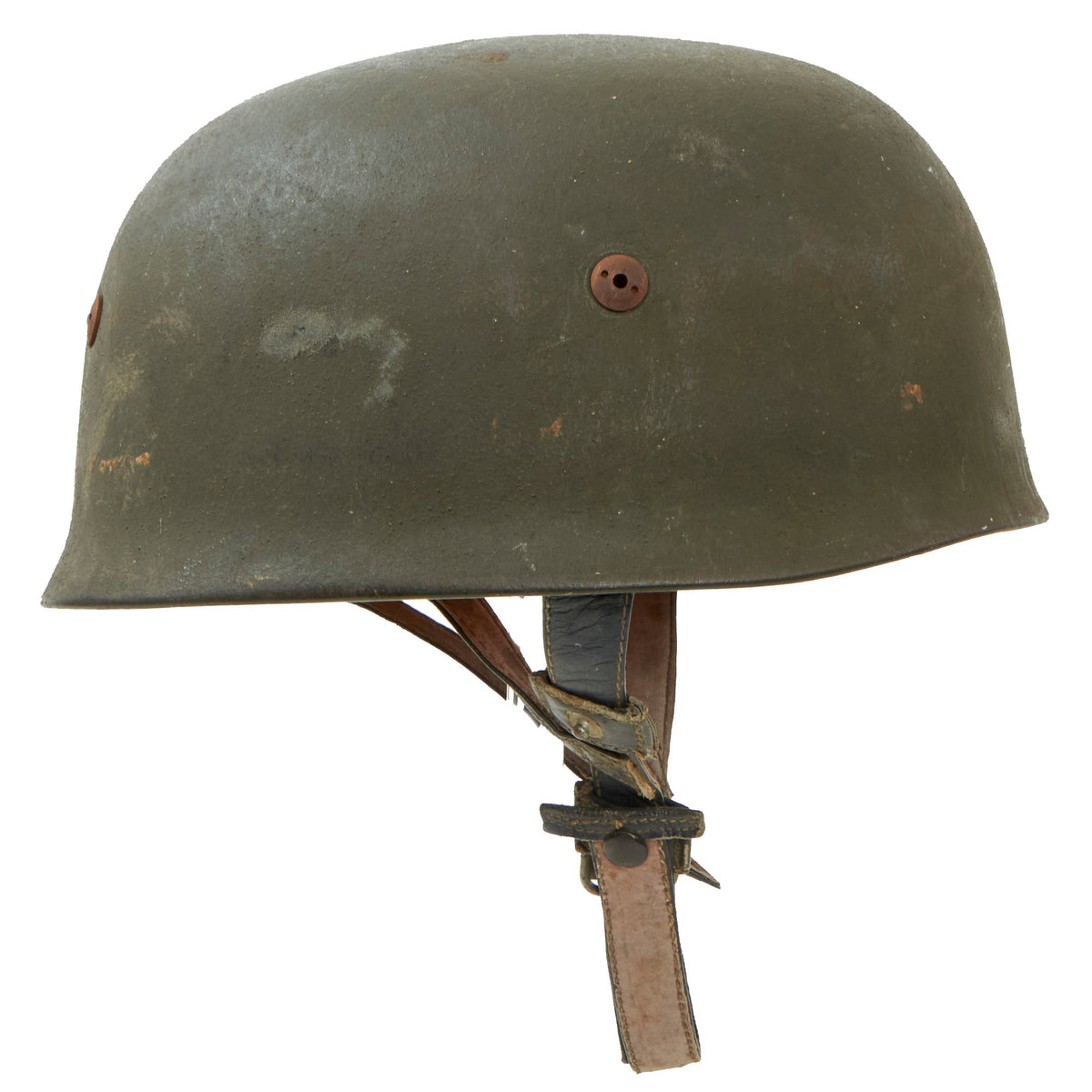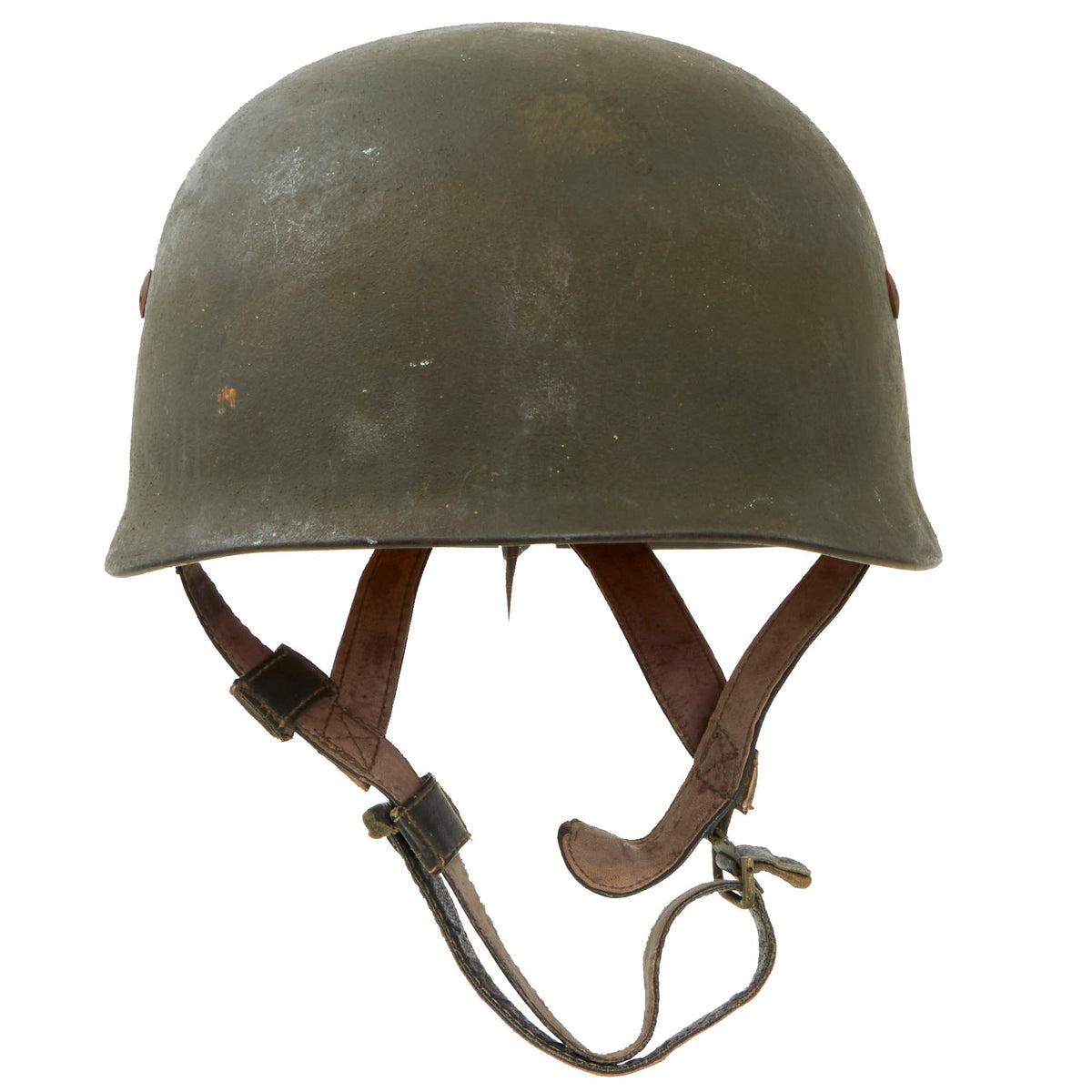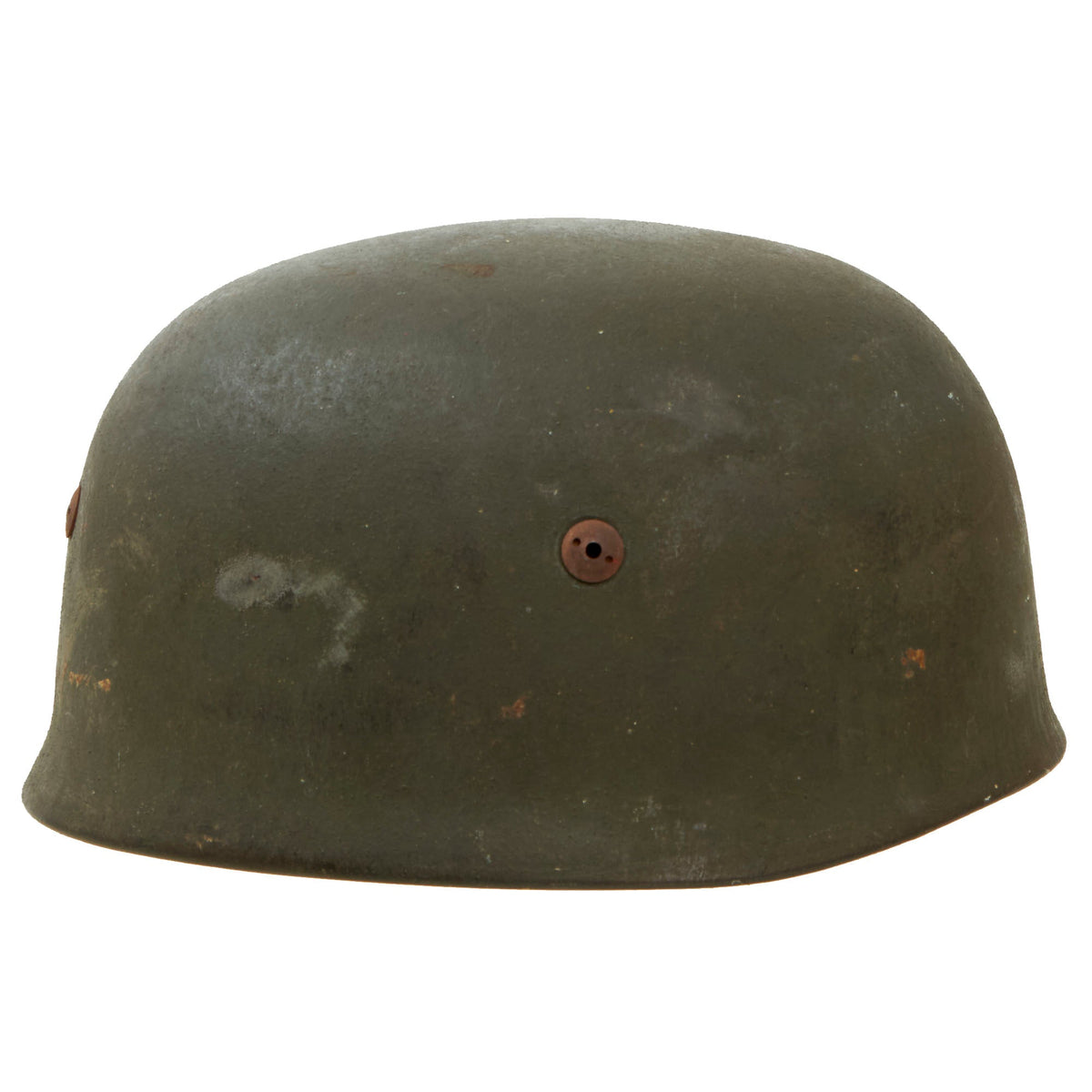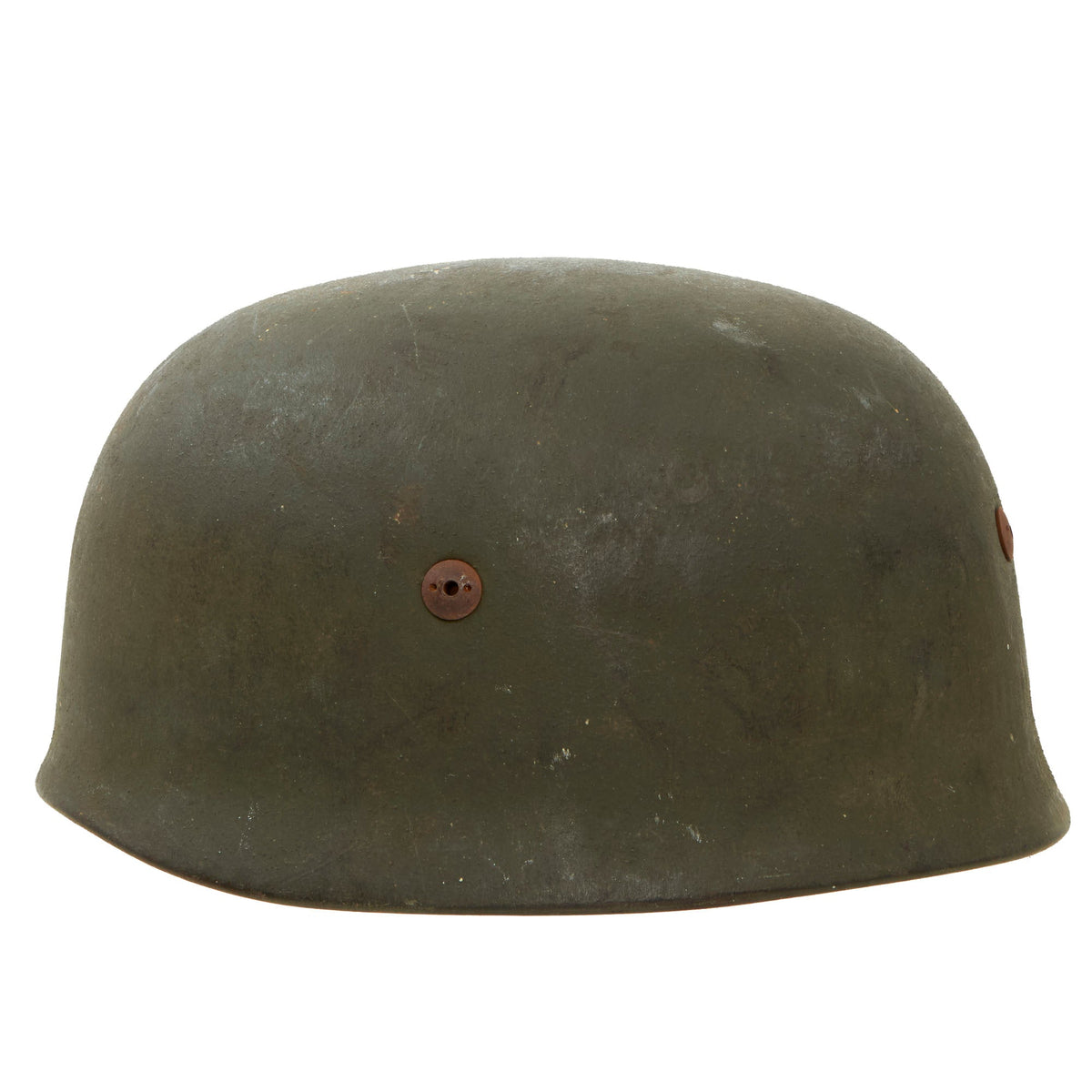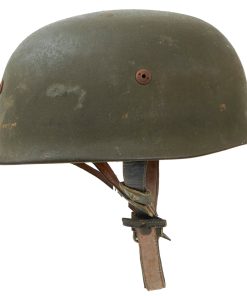Original German WWII M-38 Luftwaffe Fallschirmjäger Paratrooper Helmet with Complete 56cm Liner and Chinstraps – CKL68 Original Items
$ 8.495,00 $ 2.123,75
Original Item: Only One Available. This is an fantastic example of a later war WWII German M-38 Fallschirmjäger Helmet, complete with liner and chinstraps! We almost always see these missing some components, but this example is complete! Helmets like this do not come about very often, and it has been quite some time since we have had an M38 paratrooper of this quality. This is a later model M-38 with 2nd Pattern Liner and chinstrap fitted to the shell by the means of four vented spanner bolts held in place by aluminum nuts. We do not see any evidence the liner or chinstraps have ever been removed or modified in any way. This helmet in its entirety looks like it simply has not been touched since it was brought home by an American GI after the war!
The exterior shell retains a most of the original Feldgrau (field gray) lightly textured combat finish on the exterior. The interior paint matches the color and texture, so it does not look to have been refinished at any time during the war. It has a great lightly used look to it that is impossible to duplicate. The spanner bolts show some oxidation on the exterior, as later in the war they were often not painted, just oxide coated, so surface rust is common. There is no decal present, and no signs that there ever was one, which is quite common later in the war. We checked it thoroughly and everything is 100% correct. This is the real deal!
The rear of the skirt is stamped with CKL68 over lot number 4267, which is a bit faintly stamped but still fully legible, though partly blocked by the liner frame. We even measured the outside of the helmet, and came up with 69cm, correct for a 68 shell. All paratrooper helmets were produced by Eisenhüttenwerk AG of Thale, located in the Harz district in Saxony, Germany. They had used the abbreviation “ET” until about 1942, after which they moved to the three letter code “ckl”. This example is a shell size 68 and was produced some time in 1942 – 1945. The helmet shells were produced in two sizes, 68 and 71, and this is the smaller size 68cm shell with a liner that is sized 56cm.
The liner in the helmet is complete, and has the correct later war galvanized steel liner band with foam rubber spacers between the band and the leather of the liner. The rubber is intact, though now has become somewhat stiff with age. The leather liner is complete with NO tears, and is a nice tan color, showing only light to moderate use. The original markings are still clear, definitely a rarity! On the front side of the liner are the correct later pattern markings:
R.-Betr.-Nr. 0/0471/0043
Kopfgröße 56
Stahlhelmgröße 68
The presence of the Reichsbetriebsnummer (National Business Number or RBNr.) is correct for later issued liners, and the markings indicate that it is a correct size 56cm liner for 68cm shell
The original chinstrap is in very good shape, and still supple. From what we can see it is complete, with all components present, working snaps, and a functional buckle. There is light overall wear, with some scuffing and discoloration to the blue finish, and some of the stitching is a bit loose. Given that many of these helmets are completely missing their internal rigging, this is a real treat!
Being that this helmet was made between 1942-1945 would indicate possible issue on the Eastern Front, or to locations in Italy. As Germany lost ground and air superiority, it was much less likely that these helmets would have been used during actual jumps.
A great lightly used example with a fantastic patina! We are unlikely to have another paratrooper helmet of this quality anytime soon! Ready to add to your collection and display!
Fallschirmjägerhelm M38
Fallschirmjägerhelm M38 ( M38 Heisler / M38 ) – was a German steel paratrooper helmet intended for Fallschirmjäger airborne units from World War II. Originally, the German airborne troops used the standard Stahlhelm M35 helmets throughout the German Army . It soon turned out, however, that this helmet was not suitable for parachuting, as it caused significant air resistance during the jump. A too loosely fastened helmet could have been torn from the jumper’s head, and if it was tightly fastened it could cause suffocation.
Therefore, from 1936, work was carried out at the Eisenhüttenwerke factory to create a helmet dedicated specifically to the airborne troops. Their effect was a parachute helmet designed by engineer Karl Heisler, which under the designation M38 was adopted by the army.
The M38 helmet was derived from the standard M35 helmet. However, it was smaller, more streamlined and with a significantly reduced hood. The front part of the hood was only marked, and the rear part was shortened to 1.8 cm. (in experimental versions – 2 cm). The rims of the bell were rolled up. The helmet bell was made in a series of operations from one piece of steel sheet 1.5 mm thick. It was produced in sizes marked as 66, 68 and 71.
The internal equipment of the experimental versions of the helmet was identical to that of the standard M35 helmet. In the version adopted for equipment, a new type of fascia was used, which better protected against possible injuries. For this purpose, the bell walls were additionally lined with a shock-absorbing micro-rubber insert cut into 7 “arms” with a thickness of 10 to 13 mm. The actual fit was in the form of a leather cap with round holes cut for ventilation. Both the micro-rubber insert and the leather cap were attached to an aluminum rim with a thickness of 1 mm. All interior fittings were bolted with four screws to the helmet bell.
A new type of lining was also used in the parachute helmet. The standard two-point suspension was replaced with a four-point “Y” -shaped suspension, which ensured better fit of the helmet on the head. In the model adopted as an accessory, the straps of the lining were widened to 20 mm and latches were introduced to protect the helmet against accidental unfastening.
The helmet’s bell was initially painted gray-blue. A national-colored shield on the right side and a Luftwaffe eagle decal on the left side were put on. Later during the war, the bell was painted gray-green or sand colored. Various covers and masking nets were also used. In winter conditions, the helmet bell was painted white.
Polish tankers from the 2nd Corps of the Polish Armed Forces in the West would use captured M38 helmets. The reason for this was their small size and the fact that they fit very tightly to the head. However, they were strictly forbidden to use them, as it happened that their own infantry mistook the tankers leaving their vehicles as Germans and opened fire on them.
Fast Shipping with Professional Packaging
Thanks to our longstanding association with UPS FedEx DHL, and other major international carriers, we are able to provide a range of shipping options. Our warehouse staff is expertly trained and will wrap your products according to our exact and precise specifications. Prior to shipping, your goods will be thoroughly examined and securely secured. We ship to thousands clients each day across multiple countries. This shows how we're dedicated to be the largest retailer on the internet. Warehouses and distribution centres can be located throughout Europe as well as the USA.
Note: Orders with more than one item will be assigned a processing date depending on the item.
Before shipping before shipping, we'll conduct a thorough inspection of the items you have ordered. Today, the majority of orders will be delivered within 48 hours. The delivery time will be between 3-7 days.
Returns
The stock is dynamic and we cannot completely manage it because multiple stakeholders are involved, including our factory and warehouse. So the actual stock may alter at any time. It's possible that you may not receive your order once the order has been made.
Our policy is valid for a period of 30 days. If you don't receive the product within 30 days, we are not able to issue a refund or an exchange.
You can only return an item if it is unused and in the same state as the day you received it. You must have the item in its original packaging.
Related products
Uncategorized
Uncategorized
Uncategorized
Uncategorized
Armored Burgonet Helmet & Polearm from Scottish Castle Leith Hall Circa 1700 Original Items
Uncategorized
Uncategorized
Uncategorized
Uncategorized
Uncategorized
Band of Brothers ORIGINAL GERMAN WWII Le. F.H. 18 10.5cm ARTILLERY PIECE Original Items
Uncategorized
Uncategorized
Uncategorized
Uncategorized
Uncategorized
Uncategorized
Uncategorized
Uncategorized
Uncategorized
Uncategorized
Uncategorized
Angolan Rebel 1970s era 60mm Inert Display Mortar from Angolan Civil War Original Items
